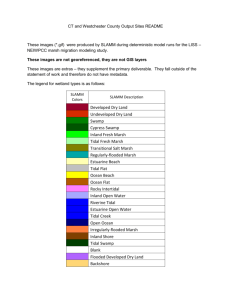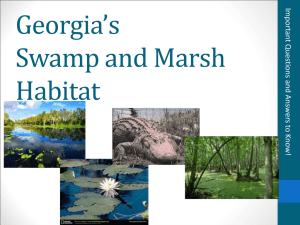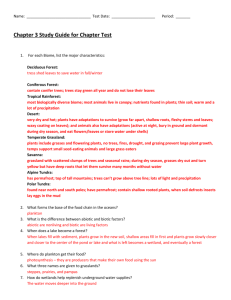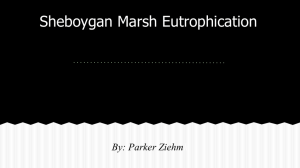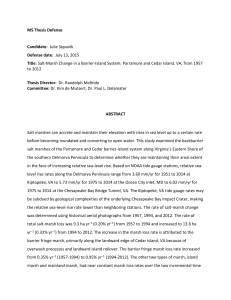model application report (MSWord format)
advertisement
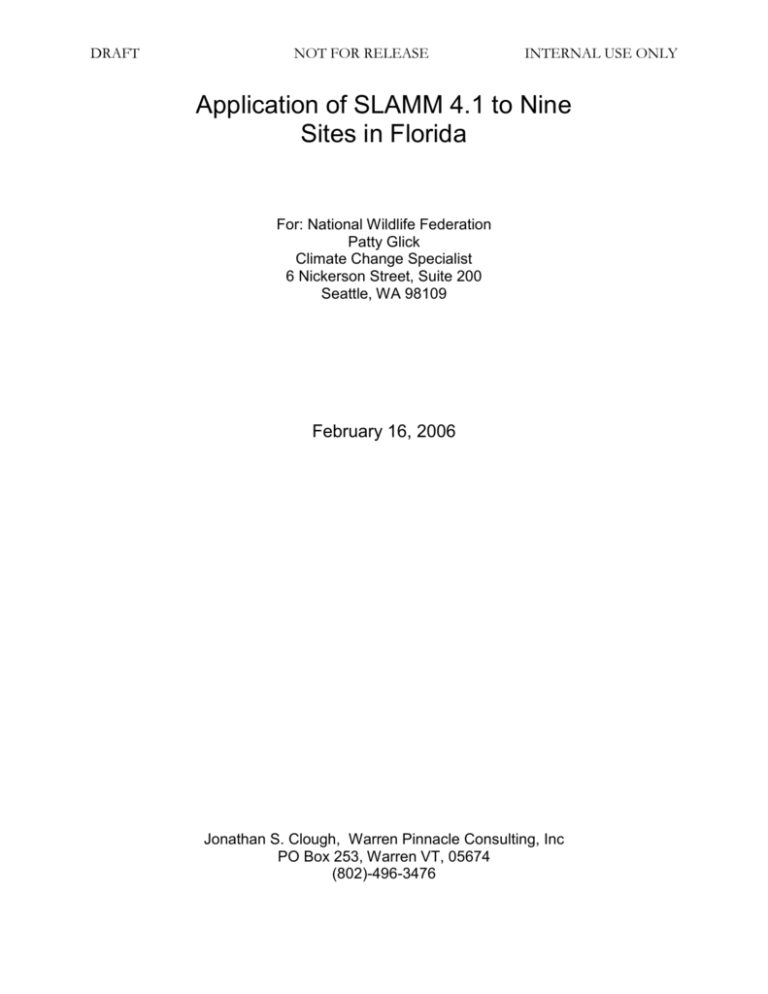
DRAFT NOT FOR RELEASE INTERNAL USE ONLY Application of SLAMM 4.1 to Nine Sites in Florida For: National Wildlife Federation Patty Glick Climate Change Specialist 6 Nickerson Street, Suite 200 Seattle, WA 98109 February 16, 2006 Jonathan S. Clough, Warren Pinnacle Consulting, Inc PO Box 253, Warren VT, 05674 (802)-496-3476 DRAFT NOT FOR RELEASE INTERNAL USE ONLY Application of SLAMM 4.1 to Nine Sites in Florida Project Background ................................................................................................................... 1 Model Summary ........................................................................................................................2 Sea Level Rise Scenarios.................................................................................................... 2 Model Results ............................................................................................................................ 4 All of Florida ......................................................................................................................................... 4 Pensacola: .............................................................................................................................................. 5 Apalachicola .......................................................................................................................................... 9 Tampa Bay...........................................................................................................................................11 Charlotte ..............................................................................................................................................13 Florida Bay ..........................................................................................................................................17 Biscayne Bay........................................................................................................................................19 Saint Lucie .................................................................................... 2Error! Bookmark not defined. Indian River Lagoon ..........................................................................................................................23 Model Parameterization .......................................................................................................... 25 DRAFT NOT FOR RELEASE INTERNAL USE ONLY Project Background The SLAMM 4.1 model was applied to nine sites within Florida, comprising over 1.7 million hectares (Figure 1). Funding for this model application was provided by the National Wildlife Federation. Extensive data processing that made this application possible was provided by Brad Nunley, NWF’s GIS expert. Figure 1: Map of Sites Modeled within Florida SLAMM Version 4.1 is the latest version of the SLAMM Model, developed in 2005 and based on SLAMM 4.0. SLAMM 4.1 provides additional sea level rise scenarios based on the latest IPCC findings (IPCC 2001) and additional data examination tools to ensure that data quality is acceptable. 1 DRAFT NOT FOR RELEASE INTERNAL USE ONLY Model flexibility has been improved with respect to accretion rates, and the model now accepts data from the USGS seamless data distribution tool (seamless.usgs.gov). To accurately model erosion in larger sites, maximum fetch is now calculated on a cell-by-cell basis rather than being input as a site characteristic. For more information on the development of the SLAMM model, please see the model’s technical documentation (Clough and Park, 2005). Model Summary Within SLAMM, there are four primary processes that affect wetland fate under different scenarios of sea level rise: Inundation: The rise of water levels and the salt boundary is tracked by reducing elevations of each cell as sea levels rise, thus keeping MTL constant at zero. The effects on each cell are calculated based on the minimum elevation and slope of that cell. Erosion: Erosion is triggered based on a threshold of maximum fetch and the proximity of the marsh to estuarine water or open ocean. When these conditions are met, horizontal erosion occurs at a rate based on site specific parameters. Overwash: Barrier islands of under 500 meter width are assumed to undergo overwash during each 25 year time-step due to storms encountered. Beach migration and transport of sediments are calculated. Saturation: Coastal swamps and fresh marshes can migrate onto adjacent uplands as a response of the water table to rising sea level close to the coast. For a thorough accounting of each of these processes and the underlying assumptions and equations, please see the model’s technical documentation. Sea Level Rise Scenarios The model was run given the minimum, mean, and maximum estimates of each of the SRES scenarios. A brief description of each of these scenarios can be found in the SLAMM 4.1 technical documentation, more extensive descriptions are in the Intergovernmental Panel on Climate Change report (IPCC 2001). For simplicity, this report will focus on the A1 scenario in which the future world includes very rapid economic growth, global population that peaks in mid-century and declines thereafter, and the rapid introduction of new and more efficient technologies. In particular, the A1B scenario assumes that energy sources will be balanced across all sources. 2 DRAFT NOT FOR RELEASE INTERNAL USE ONLY Figure 2: Summary of SRES Scenarios Global average sea level rise for the SRES scenarios Mean Estimates 1000 900 mm (mean) 800 700 A1B 600 A1T 500 A1FI 400 A2 B1 300 B2 200 100 0 1990 2010 2030 2050 2070 2090 2110 Global average sea level rise for the SRES scenarios Minimum and Maximum Estimates 1000 900 A1B MIN 800 A1T MIN A1FI MIN 700 A2 MIN mm 600 B1 MIN 500 B2 MIN 400 A1B MAX 300 A1T MAX A1FI MAX 200 A2 MAX 100 0 1990 B1 MAX B2 MAX 2040 2090 3 DRAFT NOT FOR RELEASE INTERNAL USE ONLY Model Results All of Florida Looking at the combined results of all modeled sites can be informative. At present we will focus on the mean results of sea level rise for Scenario A1B. By the year 2100, dry land is predicted to decrease by 14 percent over all sites, due to the processes of inundation and saturation. Hardwood swamp loss is predicted to be 12%. Nearly 50% of salt marsh is predicted to be lost over all sites by the year 2100. Due to the inundation of dry land, transitional salt marsh (brackish marsh) is predicted to increase dramatically. The model also predicts roughly a 40% loss of ocean beaches and that two thirds of estuarine beaches will disappear (primarily to erosion, but also due to overwash, and inundation). As sea levels rise, open ocean and estuarine water is predicted to increase. Mangroves are also expected to thrive under these conditions, gaining by 33%. SLAMM Predictions of Marsh Fate under Scenario A1B, Mean (Max) for all Sites Modeled in Florida Dry Land Hardwood Swamp Cypress Swamp Inland Fresh Marsh Tidal Fresh Marsh Transitional Salt Marsh Saltmarsh Mangrove Estuarine Beach Tidal Flat Ocean Beach Rocky Intertidal Inland Open Water Riverine Tidal Estuarine Open Water Open Ocean Sum of Categories (ha) Init. Cond. (ha) 496,043 175,319 2,955 56,129 1,915 684 19,328 104,462 3,530 80,458 1,292 21 15,055 493 508,769 261,355 1,727,807 Year 2100 (ha) 425,363 156,699 2,287 53,505 1,745 30,520 10,034 141,928 1,150 13,020 887 21 12,609 179 602,246 275,615 1,727,807 Initial Condition Percent of Percent Loss Percent Init. Cond. (mean) Loss (max) 29% 14% 22% 10% 11% 20% 0% 23% 41% 3% 5% 24% 0% 9% 11% 0% -4364% -3690% 1% 48% -75% 6% -36% -68% 0% 67% 72% 5% 84% 86% 0% 31% -8% 0% 0% 0% 1% 16% 21% 0% 64% 71% 29% -18% -21% 15% -5% -6% Year 2100 Dry Land Hardwood Swamp Cypress Swamp Inland Fresh Marsh Tidal Fresh Marsh Transitional Salt Marsh Saltmarsh Mangrove Estuarine Beach Tidal Flat Ocean Beach Rocky Intertidal Inland Open Water Riverine Tidal Estuarine Open Water 4 Open Ocean DRAFT NOT FOR RELEASE INTERNAL USE ONLY If we run the model using the “maximum” estimates for scenario A1B, loss of dry land increases to 22% (from 14%), but salt marsh actually increases by 75% as dry land is converted beyond transitional marsh into pure salt marsh due to continuing inundation. Mangroves do even better under scenarios of higher sea level rise, gaining by over 60% under the maximum scenario. Pensacola: Relatively steep slopes of dry land around Pensacola, FL result in a relatively low loss rate for dry land (6-7%), the majority of dry-land loss is predicted due to saturation (increase of height of water table leading to fresh marsh expansion) rather than inundation. Some migration of the barrier islands are predicted with a two thirds loss of ocean beach under the mean scenario. Salt marsh in this region is predicted to be quite vulnerable, however, with a loss of over 70% in both the mean and maximum parameter set. SLAMM Predictions of Marsh Fate under Scenario A1B, Mean (Max) for Pensacola, FL Dry Land Hardwood Swamp Cypress Swamp Inland Fresh Marsh Tidal Fresh Marsh Transitional Salt Marsh Saltmarsh Mangrove Estuarine Beach Tidal Flat Ocean Beach Rocky Intertidal Inland Open Water Riverine Tidal Estuarine Open Water Open Ocean Sum of Categories (ha) Init. Cond. (ha) 64,476 16,697 128 2,814 19 70 2,785 54 59 470 45 917 46,256 17,471 152,261 5 Year 2100 Percent of Percent Loss Percent (ha) Init. Cond. (mean) Loss (max) 60,580 42% 6% 7% 17,240 11% -3% 1% 122 0% 5% 5% 2,931 2% -4% -1% 19 0% 0% 0% 536 0% -668% -1268% 753 2% 73% 77% 54 0% 0% 0% 38 0% 36% -77% 449 0% 4% 23% 15 0% 67% 28% 0% NA NA 761 1% 17% 18% 0% NA NA 50,986 30% -10% -12% 17,778 11% -2% -2% 152,261 DRAFT NOT FOR RELEASE INTERNAL USE ONLY SLAMM Predictions of Marsh Fate under Scenario A1B, Mean for Pensacola, FL Initial Condition Year 2100 Dry Land Hardwood Swamp Cypress Swamp Inland Fresh Marsh Tidal Fresh Marsh Transitional Salt Marsh Saltmarsh Mangrove Estuarine Beach Tidal Flat Ocean Beach Rocky Intertidal Inland Open Water Riverine Tidal Estuarine Open Water Open Ocean Legend for All SLAMM ScreenCapture Maps: 6 DRAFT NOT FOR RELEASE Pensacola, FL Current Condition Pensacola, FL Year 2100, A1B Mean 7 INTERNAL USE ONLY DRAFT NOT FOR RELEASE INTERNAL USE ONLY Detail of Elevational Map for Pensacola, FL Barrier Islands 8 DRAFT NOT FOR RELEASE INTERNAL USE ONLY Apalachicola Significant loss of hardwood swamp is predicted, particularly along the Apalachicola river where swamp elevations are low relative to sea level. SLAMM predicts that 13-16 percent of these swamps will convert to brackish (transitional) salt marsh. Inundation and saturation is also predicted to convert over a quarter of the dry land on this site, again, particularly along the river basin. Overwash is predicted to have significant effects on the barrier islands to the south of this site. SLAMM Predictions of Marsh Fate under Scenario A1B, Mean (Max) for Apalachicola FL Dry Land Hardwood Swamp Cypress Swamp Inland Fresh Marsh Tidal Fresh Marsh Transitional Salt Marsh Saltmarsh Mangrove Estuarine Beach Tidal Flat Ocean Beach Rocky Intertidal Inland Open Water Riverine Tidal Estuarine Open Water Open Ocean Sum of Categories (ha) Init. Cond. (ha) 34,921 126,599 64 9,318 159 349 7,164 60 1,739 531 1 18 3,033 396 56,051 51,387 291,791 Year 2100 (ha) 25,218 110,640 38 6,787 38 22,193 2,828 60 222 3,787 131 18 1,937 103 64,640 53,150 291,791 Percent of Percent Loss Percent Init. Cond. (mean) Loss (max) 12% 28% 33% 43% 13% 16% 0% 41% 56% 3% 27% 34% 0% 76% 91% 0% -6264% -1301% 2% 61% -234% 0% 0% 6% 1% 87% 89% 0% -613% -382% 0% -8978% -10597% 0% 0% 0% 1% 36% 42% 0% 74% 82% 19% -15% -24% 18% -3% -4% SLAMM Predictions of Marsh Fate under Scenario A1B, Mean for Apalachicola , FL Initial Condition Year 2100 Dry Land Hardwood Swamp Cypress Swamp Inland Fresh Marsh Tidal Fresh Marsh Transitional Salt Marsh Saltmarsh Mangrove Estuarine Beach Tidal Flat Ocean Beach Rocky Intertidal Inland Open Water Riverine Tidal Estuarine Open Water Open Ocean 9 DRAFT NOT FOR RELEASE Apalachicola, FL Current Condition Apalachicola, FL Year 2100, A1B Mean 10 INTERNAL USE ONLY DRAFT NOT FOR RELEASE INTERNAL USE ONLY Tampa Bay Tidal flats around Tampa bay are predicted to nearly disappear by the year 2100. The barrier islands around Tampa bay are also predicted to be hit hard, with a resulting loss of 10% to 16% of dry lands for the site. Some cypress swamp saturation is also predicted to occur. Mangroves are predicted to roughly double or triple at the site depending on whether the mean or maximum scenario is evaluated. SLAMM Predictions of Marsh Fate under Scenario A1B, Mean (Max) for Tampa Bay, FL Dry Land Hardwood Swamp Cypress Swamp Inland Fresh Marsh Tidal Fresh Marsh Transitional Salt Marsh Saltmarsh Mangrove Estuarine Beach Tidal Flat Ocean Beach Rocky Intertidal Inland Open Water Riverine Tidal Estuarine Open Water Open Ocean Sum of Categories (ha) Init. Cond. (ha) 147,401 8,882 897 2,196 16 59 1,200 7,533 331 17,973 59 0 2,189 23 85,010 49,557 323,326 Year 2100 (ha) 133,362 8,264 969 2,073 7 81 167 20,055 317 690 125 0 2,072 3 102,722 52,421 323,326 Percent of Percent Loss Percent Init. Cond. (mean) Loss (max) 46% 10% 16% 3% 7% 15% 0% -8% -9% 1% 6% 12% 0% 59% 93% 0% -36% -186% 0% 86% 90% 2% -166% -294% 0% 4% 37% 6% 96% 98% 0% -112% -148% 0% 0% 0% 1% 5% 8% 0% 87% 92% 26% -21% -22% 15% -6% -7% SLAMM Predictions of Marsh Fate under Scenario A1B, Mean for Tampa Bay, FL Initial Condition Year 2100 Dry Land Hardwood Swamp Cypress Swamp Inland Fresh Marsh Tidal Fresh Marsh Transitional Salt Marsh Saltmarsh Mangrove Estuarine Beach Tidal Flat Ocean Beach Rocky Intertidal Inland Open Water Riverine Tidal Estuarine Open Water Open Ocean 11 DRAFT NOT FOR RELEASE Tampa Bay, FL Current Condition Tampa Bay, FL Year 2100, A1B Mean 12 INTERNAL USE ONLY DRAFT NOT FOR RELEASE INTERNAL USE ONLY Charlotte Like Tampa Bay, significant overwash is predicted for the barrier islands around Charlotte resulting in much dry land loss. Saturation and inundation also take their toll with dry land predicted to drop a whopping 35-55% depending on whether the mean or maximum scenario is run. Tidal flats are also predicted to be decimated by sea level rise. Mangroves thrive under these scenarios, though, increasing by 75% to 120%. Results in this region are similar to Tampa Bay, though lower elevations of dry land result in more significant predicted impacts here. SLAMM Predictions of Marsh Fate under Scenario A1B, Mean (Max) for Charlotte, FL Dry Land Hardwood Swamp Cypress Swamp Inland Fresh Marsh Tidal Fresh Marsh Transitional Salt Marsh Saltmarsh Mangrove Estuarine Beach Tidal Flat Ocean Beach Rocky Intertidal Inland Open Water Riverine Tidal Estuarine Open Water Open Ocean Sum of Categories (ha) Init. Cond. Year 2100 Percent of Percent Loss Percent (ha) (ha) Init. Cond. (mean) Loss (max) 37,805 24,468 23% 35% 55% 5,000 3,196 3% 36% 51% 31 32 0% -5% -5% 1,261 1,036 1% 18% 55% 0% NA NA 73 15 0% 80% -167% 1,384 151 1% 89% 98% 18,577 32,535 11% -75% -119% 492 143 0% 71% 76% 22,835 612 14% 97% 99% 97 70 0% 27% -133% 3 3 0% 0% 0% 517 212 0% 59% 73% 0% NA NA 50,921 74,501 31% -46% -48% 22,691 24,711 14% -9% -11% 161,685 161,685 SLAMM Predictions of Marsh Fate under Scenario A1B, Mean for Charlotte, FL Initial Condition Year 2100 Dry Land Hardwood Swamp Cypress Swamp Inland Fresh Marsh Tidal Fresh Marsh Transitional Salt Marsh Saltmarsh Mangrove Estuarine Beach Tidal Flat Ocean Beach Rocky Intertidal Inland Open Water Riverine Tidal Estuarine Open Water Open Ocean 13 DRAFT NOT FOR RELEASE Charlotte, FL Current Condition INTERNAL USE ONLY Charlotte, FL Year 2100, A1B Mean 14 DRAFT NOT FOR RELEASE INTERNAL USE ONLY Ten Thousand Islands What little dry land is at this site is predicted to be lost under these sea level rise scenarios (or at least 80-90% of it). Tidal flats are predicted to migrate further inland while Mangroves, which are already dominant at this site increase from 16% to 26%. Mangrove migration takes its toll on inland fresh marsh which decreases by 44% to 79% depending on the scenario evaluated. Over half of salt marsh also is lost in both scenarios. Some fresh marsh is also predicted to be converted to transitional (brackish) salt marsh, which was not initially present at the site. SLAMM Predictions of Marsh Fate under Scenario A1B, Mean (Max) for Ten Thousand Islands, FL Dry Land Hardwood Swamp Cypress Swamp Inland Fresh Marsh Tidal Fresh Marsh Transitional Salt Marsh Saltmarsh Mangrove Estuarine Beach Tidal Flat Ocean Beach Rocky Intertidal Inland Open Water Riverine Tidal Estuarine Open Water Open Ocean Sum of Categories (ha) Init. Cond. (ha) 3,274 5,744 1,198 7,485 3,667 32,500 84 2,337 10 91 16,865 33,073 106,328 Year 2100 Percent of Percent Loss Percent (ha) Init. Cond. (mean) Loss (max) 654 3% 80% 90% 3,963 5% 31% 83% 988 1% 18% 56% 4,225 7% 44% 79% 0% NA NA 1,946 0% NA NA 898 3% 76% 51% 37,857 31% -16% -26% 58 0% 30% 76% 3,117 2% -33% -18% 53 0% -424% -408% 0% NA NA 48 0% 48% 91% 0% NA NA 17,388 16% -3% -11% 35,133 31% -6% -7% 106,328 SLAMM Predictions of Marsh Fate under Scenario A1B, Mean for Ten Thousand Islands, FL Initial Condition Year 2100 Dry Land Hardwood Swamp Cypress Swamp Inland Fresh Marsh Tidal Fresh Marsh Transitional Salt Marsh Saltmarsh Mangrove Estuarine Beach Tidal Flat Ocean Beach Rocky Intertidal Inland Open Water Riverine Tidal Estuarine Open Water Open Ocean 15 DRAFT NOT FOR RELEASE INTERNAL USE ONLY Ten Thousand Islands, Current Condition Ten Thousand Islands, FL Year 2100, A1B Mean 16 DRAFT NOT FOR RELEASE INTERNAL USE ONLY Florida Bay In Florida Bay, the most significant prediction is the loss of tidal flats which are currently dominant. Under both scenarios, 99% of tidal flats are predicted to be lost. Mangroves, on the other hand, hang tough with losses of only 3% to 6% due to inundation. At least half of the small amount of dry land at this site is predicted to be lost under the A1B mean and maximum scenarios. SLAMM Predictions of Marsh Fate under Scenario A1B, Mean (Max) for Florida Bay, FL Dry Land Hardwood Swamp Cypress Swamp Inland Fresh Marsh Tidal Fresh Marsh Transitional Salt Marsh Saltmarsh Mangrove Estuarine Beach Tidal Flat Ocean Beach Rocky Intertidal Inland Open Water Riverine Tidal Estuarine Open Water Open Ocean Sum of Categories (ha) Init. Cond. (ha) 1,269 8 13 1,232 33,402 485 32,561 226 118,336 3,959 191,489 Year 2100 (ha) 616 5 9 839 32,294 52 484 54 152,477 4,660 191,489 Percent of Percent Loss Percent Init. Cond. (mean) Loss (max) 1% 51% 70% 0% 34% 50% 0% NA NA 0% NA NA 0% NA NA 0% 30% 100% 1% 32% 100% 17% 3% 6% 0% 89% 95% 17% 99% 99% 0% 76% 71% 0% NA NA 0% NA NA 0% NA NA 62% -29% -31% 2% -18% -19% SLAMM Predictions of Marsh Fate under Scenario A1B, Mean for Florida Bay, FL Initial Condition Year 2100 Dry Land Hardwood Swamp Cypress Swamp Inland Fresh Marsh Tidal Fresh Marsh Transitional Salt Marsh Saltmarsh Mangrove Estuarine Beach Tidal Flat Ocean Beach Rocky Intertidal Inland Open Water Riverine Tidal Estuarine Open Water Open Ocean 17 DRAFT NOT FOR RELEASE Florida Bay, Current Condition Florida Bay, FL Year 2100, A1B Mean 18 INTERNAL USE ONLY DRAFT NOT FOR RELEASE INTERNAL USE ONLY Biscayne Bay In Biscayne Bay, the most heavily developed areas in the northwest portion of the study map are not predicted to suffer extensive losses from sea level rise as these developments are built on relatively high land elevations. Further south, however, lesser developed low lying dry land and freshwater wetlands are predicted to suffer significant inundation effects. The barrier islands at the south of the map are also predicted to undergo inundation and subsequent mangrove expansion, especially under the maximum scenario. The resulting prediction is a loss of dry-land that ranges from 13-30% depending on whether the mean or maximum scenario is evaluated. Given land elevations at this site, a potential exists for expansion of hardwood swamps as the overall water-table rises. However, this potential is likely to be thwarted due to the extent of developed land. The model also predicts that such potential would be short-lived; as the salt level rises, these freshwater swamps are converted into transitional salt marsh under the maximum scenario. Fresh water marshes suffer a 33% to 89% loss under the two scenarios. As is often the case, transitional salt marsh and mangrove stands have the potential to increase significantly under these two scenarios of sea level rise as dry lands and fresh marshes undergo inundation. Beach erosion is predicted to claim roughly one third of existing beaches on these sites. SLAMM Predictions of Marsh Fate under Scenario A1B, Mean (Max) for Biscayne Bay, FL Dry Land Hardwood Swamp Cypress Swamp Inland Fresh Marsh Tidal Fresh Marsh Transitional Salt Marsh Saltmarsh Mangrove Estuarine Beach Tidal Flat Ocean Beach Rocky Intertidal Inland Open Water Riverine Tidal Estuarine Open Water Open Ocean Sum of Categories (ha) Init. Cond. (ha) 57,841 3,993 589 7,846 119 1,387 8,556 225 3,340 1,815 80,428 5,794 171,934 19 Year 2100 Percent of Percent Loss Percent (ha) Init. Cond. (mean) Loss (max) 50,278 34% 13% 30% 5,656 2% -42% 86% 86 0% 85% 100% 5,224 5% 33% 89% 0% NA NA 1,642 0% -1278% -4310% 639 1% 54% -32% 14,654 5% -71% -230% 47 0% 79% 69% 702 2% 79% 87% 94 0% NA NA 0% NA NA 1,326 1% 27% 38% 0% NA NA 82,758 47% -3% -4% 8,828 3% -52% -54% 171,934 DRAFT NOT FOR RELEASE INTERNAL USE ONLY SLAMM Predictions of Marsh Fate under Scenario A1B, Mean for Biscayne Bay, FL Initial Condition Year 2100 Dry Land Hardwood Swamp Cypress Swamp Inland Fresh Marsh Tidal Fresh Marsh Transitional Salt Marsh Saltmarsh Mangrove Estuarine Beach Tidal Flat Ocean Beach Rocky Intertidal Inland Open Water Riverine Tidal Estuarine Open Water Open Ocean Biscayne Bay, Current Condition Biscayne Bay, FL Year 2100, A1B Mean 20 DRAFT NOT FOR RELEASE INTERNAL USE ONLY Saint Lucie The two dominant processes predicted to affect Saint Lucie are overwash of the barrier islands and saturation of dry land. Inland elevations of dry land are low, especially in relation to the inland fresh marsh that occurs close to the bay. This results in significant predictions of saturation and a loss of 10 to 12% of dry land (which is comprises more than 50% of this site). Because this part of Saint Lucie is heavily developed, this prediction should probably be considered the “potential” for saturation as this process is likely to be offset by landowners bringing in fill when required. Beach erosion and overwash is predicted to result in the loss of roughly half of the ocean beach at this site. SLAMM Predictions of Marsh Fate under Scenario A1B, Mean (Max) for Saint Lucie, FL Dry Land Hardwood Swamp Cypress Swamp Inland Fresh Marsh Tidal Fresh Marsh Transitional Salt Marsh Saltmarsh Mangrove Estuarine Beach Tidal Flat Ocean Beach Rocky Intertidal Inland Open Water Riverine Tidal Estuarine Open Water Open Ocean Sum of Categories (ha) Init. Cond. Year 2100 Percent of Percent Loss Percent (ha) (ha) Init. Cond. (mean) Loss (max) 74,677 67,169 54% 10% 12% 2,275 2,312 2% -2% 5% 0% NA NA 8,425 13,465 6% -60% -66% 0% NA NA 0 0% NA NA 405 3 0% 99% 100% 3,231 3,871 2% -20% -43% 97 232 0% -139% -88% 216 252 0% -16% 32% 301 62 0% 80% 47% 0% NA NA 1,025 1,048 1% -2% -2% 73 73 0% 0% 3% 15,864 17,134 12% -8% -10% 30,738 31,706 22% -3% -3% 137,328 137,328 SLAMM Predictions of Marsh Fate under Scenario A1B, Mean for Saint Lucie, FL Initial Condition Year 2100 Dry Land Hardwood Swamp Cypress Swamp Inland Fresh Marsh Tidal Fresh Marsh Transitional Salt Marsh Saltmarsh Mangrove Estuarine Beach Tidal Flat Ocean Beach Rocky Intertidal Inland Open Water Riverine Tidal Estuarine Open Water Open Ocean 21 DRAFT NOT FOR RELEASE Saint Lucie, FL Current Condition INTERNAL USE ONLY Saint Lucie, FL Year 2100, A1B Mean 22 DRAFT NOT FOR RELEASE INTERNAL USE ONLY Indian River Lagoon As was the case in Saint Lucie, saturation is again an important process at this east coast site resulting in a loss of 15% to 25% of dry land (depending on scenario). Again, as this is a heavily developed site this may be more a prediction of costs to be imposed on landowners rather than an actual loss of dry land. Under the maximum scenario, some of the fresh marsh at the site is converted into transitional salt marsh by the year 2100. Overwash is not predicted to be important at this site, but beach erosion does claim roughly 50% of ocean beach under both scenarios. SLAMM Predictions of Marsh Fate under Scenario A1B, Mean (Max) for Indian River Lagoon, FL Dry Land Hardwood Swamp Cypress Swamp Inland Fresh Marsh Tidal Fresh Marsh Transitional Salt Marsh Saltmarsh Mangrove Estuarine Beach Tidal Flat Ocean Beach Rocky Intertidal Inland Open Water Riverine Tidal Estuarine Open Water Open Ocean Sum of Categories (ha) Init. Cond. (ha) 74,380 6,121 48 16,784 1,720 1 104 549 18 195 554 5,468 39,039 46,685 191,665 Year 2100 Percent of Percent Loss Percent (ha) Init. Cond. (mean) Loss (max) 63,019 39% 15% 25% 5,422 3% 11% 25% 53 0% -9% -8% 17,764 9% -6% 11% 1,681 1% 2% 3% 4,098 0% -569031% -1515643% 3,755 0% -3512% -5135% 548 0% 0% 0% 41 0% -128% -264% 2,927 0% -1398% -2117% 284 0% 49% 50% 0% NA NA 5,205 3% 5% 7% 0% NA NA 39,640 20% -2% -4% 47,229 24% -1% -2% 191,665 SLAMM Predictions of Marsh Fate under Scenario A1B, Mean for Indian River Lagoon, FL Initial Condition Year 2100 Dry Land Hardwood Swamp Cypress Swamp Inland Fresh Marsh Tidal Fresh Marsh Transitional Salt Marsh Saltmarsh Mangrove Estuarine Beach Tidal Flat Ocean Beach Rocky Intertidal Inland Open Water Riverine Tidal Estuarine Open Water Open Ocean 23 DRAFT NOT FOR RELEASE Indian River Lagoon, FL Current Condition INTERNAL USE ONLY Indian River Lagoon, FL Year 2100, A1B Mean 24 DRAFT NOT FOR RELEASE INTERNAL USE ONLY Model Parameterization Digital Elevation Maps were downloaded using the USGS seamless data distribution tool (http://seamless.usgs.gov). NWI maps were downloaded as polygons and converted to rasters with the appropriate SLAMM category (http://www.nwi.fws.gov/). NOAA data were gathered from 35 sites (Figure 1) to parameterize the model for tidal range, inland tidal range, and “NGVD88 to Mean Tide Level” corrections. See the table below for a summary of NOAA data used to derive parameters. NOAA Stations, Tide Range, and MTL Corrections 8729840 8729824 8729831 8729808 PENSACOLA, PENSACOLA BAY , FL FLORIDATOWN, ESCAMBIA BAY , FL FERRY PASS, ESCAMBIA BAY , FL LITTLE SABINE BAY , FL 8728711 APALACHICOLA RIVER , FL 8728694 WHITE BEACH, EAST BAY , FL 8728690 APALACHICOLA, AP. RIVER , FL 0.383 0.442 0.421 0.392 towards water BG1732 most inland inland most ocean 0.094 0.412 0.601 0.492 inland inland most ocean AS0240 NA NA 0.061 AG7403 -0.131 AG7535 -0.098 AD7844 -0.225 AC3180 -0.18 AC3180 AA0428 AA0300 -0.18 -0.213 -0.308 AF3181 -0.311 AF3186 AF6971 -0.253 -0.298 AK3003 -0.326 AC2177 -0.271 AC2055 -0.256 AC1173 -0.256 8726364 8726428 8726277 8726573 MULLET KEY, TAMPA BAY , FL TIERRA VERDE, FL FORT HAMER, FL GADSDEN POINT, TAMPA BAY , FL 0.634 0.659 0.686 0.75 ocean ocean inland inland 8725781 8725685 8725665 8725366 SHELL CREEK, PEACE RIVER, FL CUTOFF SOUTH LITTLE GASPARILLA ISLAND ESTERO ISLAND 0.668 0.454 0.464 inland ocean ocean 8724992 ADDISON BAY, FL 8724951 PANTHER KEY, FL 8724919 CHOKOLOSKEE , FL 0.884 1.286 0.968 inland ocean inland 8724919 CHOKOLOSKEE , FL 8723797 ISLAMORADA 0.968 0.462 0.322 ocean 0.353 0.367 0.908 0.329 0.476 inland most inland inland inland ocean 1.209 1.214 1.211 ocean ocean ocean 0.723 0.654 0.649 0.511 0.77 0.543 estuarine ocean most inland ocean ocean inland 8724008 KNIGHT KEY CHANNEL , FL 8722371 8722334 8722212 8722357 8722414 SEWALL POINT. ST. LUCIE RIVER , FL NORTH FORK, ST. LUCIE RIVER , FL FORT PIERCE, SOUTH JETTY , FL STUART, ST. LUCIE RIVER , FL GOMEZ , FL 8721604 TRIDENT PIER, PORT CANAVERAL , FL 8721804 CANOVA, FL 8721649 COCOA BEACH, ATLANTIC OCEAN , FL 8723165 8723232 8723289 8723355 8723393 8723423 MIAMI, BISCAYNE BAY , FL KEY BISCAYNE YACHT CLUB , FL CUTLER, BISCAYNE BAY , FL RAGGED KEY NO. 5, BISCAYNE BAY , FL ELLIOTT KEY (OUTSIDE) , FL TURKEY POINT, BISCAYNE BAY , FL 25 DRAFT INTERNAL USE ONLY Historic sea level rise trend data were downloaded from NOAA and spatially interpolated as necessary. Variation in historic trends were relatively minor (figure below) Historic Sea Level Rise Trends Measured at NOAA Stations 3 2.5 2 1.5 1 0.5 Vaca Key, Florida Mayport, Florida Miami Beach, Florida Key West, Florida Naples, Florida Fort Myers, Florida St. Petersburg, Florida Apalachicola, Florida 0 Pensacola, Florida mm per year NOT FOR RELEASE . 26 DRAFT NOT FOR RELEASE INTERNAL USE ONLY Erosion rates were set to SLAMM defaults. Default erosion rates are 2.0 horizontal meters per year for marshes, 1.0 meter per year for swamps, and 0.5 meters per year for tidal flats. These rates are based on a combination of professional judgment and a brief literature survey. (Note also that these erosion rates presume that a threshold for erosion has been exceeded prior to the incidence of horizontal erosion. See the technical documentation for more information.) Accretion rates were set to 2.25 mm/year for salt marshes, 3.75 mm/year for brackish marsh, and 4.0 mm/year for tidal flats. These data were based on measurements from the Altamaha River in Georgia (Personal Communication, Dr. Christopher Craft.) However a literature review of accretion rates, including several measurements from Florida sites, indicate that the above rates are comfortably in-line with measurements taken throughout Florida (D. R. Cahoon, J. W. Day, Jr., and D. J. Reed, 1999. The influence of surface and shallow subsurface soil processes on wetland elevation: A synthesis. Current Topics in Wetland Biogeochemistry, 3, 72-88. ) (D. R. Cahoon, D. J. Reed, J. W. Day, Jr., 1995. Estimating shallow subsidence in microtidal salt marshes of the southeastern United States: Kaye and Barghoorn revisited. Marine Geology, 128, 1-9.) 27
